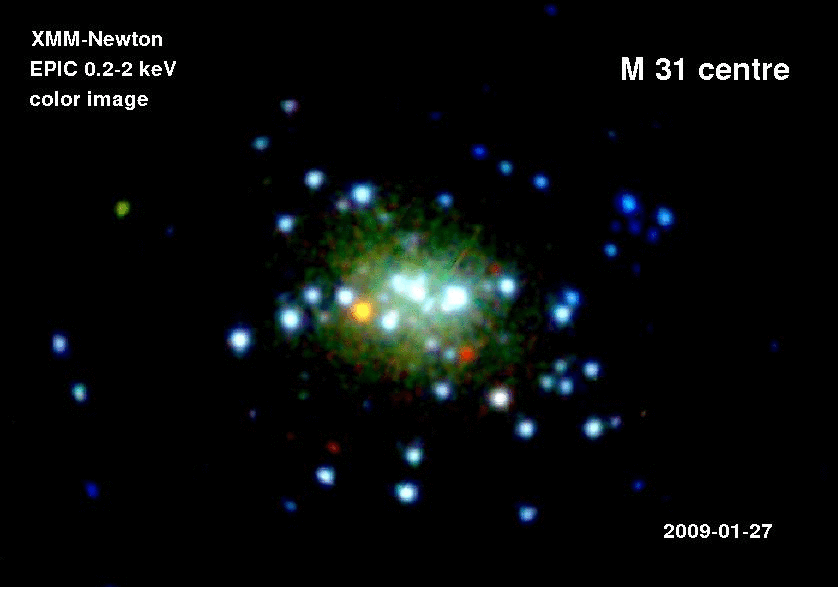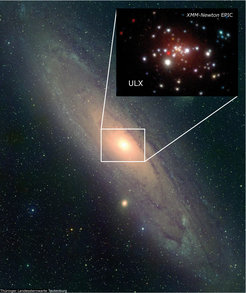First ultraluminous source in Andromeda galaxy unmasked as stellar mass black hole

Ultraluminous X-ray sources (ULX) represent a contentious set of objects, which emit at remarkably high luminosities. They can be found in both the nearby and the distant Universe, where they are seen in the outer regions of galaxies (see note 1). As they are fairly rare, with usually only one or two ULX in one galaxy - if they are present at all - the sparse data available to astronomers gave rise to two competing explanations for their high luminosities: Either a stellar mass black holes (see note 2) is accreting at extreme rates or there is a new sub-species of intermediate mass black holes (IMBH - see note 3) accreting at lower rates. One of the greatest difficulties in attempting to find the right answer is the large distance to these objects, which makes detailed observations difficult or even impossible.
Two research teams now report on observations of an unusual X-ray transient light source in Andromeda (M31), our nearest big neighbour galaxy at a distance of "only" some two million light-years. Andromeda is monitored on a regular basis by the X-ray satellite observatories Chandra and XMM-Newton as part of an on-going campaign led by scientists at the Max Planck Institute for Extraterrestrial Physics. First detected in late 2009 by Chandra, the new object was immediately classified as a low luminosity ULX by the MPE researchers, even though initially it was more luminous than the total X-ray luminosity of the Andromeda galaxy. This is therefore not only the first ULX in this spiral galaxy but also the closest ULX ever observed. Follow-up observations with the Swift and HST satellites yielded important complementary data for this remarkable ULX.

Image: Landessternwarte Tautenburg, XMM-Newton, MPE
"We were very lucky that we caught the ULX early enough to see most of its lightcurve, which showed a very similar behaviour to other X-ray sources from our own galaxy," explains Wolfgang Pietsch from the Max Planck Institute for Extraterrestrial Physics. The emission decayed exponentially with a characteristic timescale of about one month, which is a common property of stellar mass X-ray binaries. "This means that the ULX in Andromeda likely contains a normal, stellar black hole swallowing material at very high rates."
Another indication about the physical processes around the black hole comes from the changing shape of the X-ray spectrum as the emission decays. This could mean that the high luminosities involved cause the inner regions to expand outwards into a "photosphere". Alternatively, we could have a much clearer view to this source compared to other sources in our own galaxy. In either case, this is the first time that a lower luminosity ULX is linked unambiguously to a stellar mass black hole at least 13 times more massive than our Sun.
Ideally, the astronomers would like to replicate these findings by re-observing the source in another outburst. However, if it is indeed analogous to the X-ray binaries in our own Milky Way, astronomers may be in for a long wait: such outbursts occur on the order of decades. On the other hand, as there are so many X-ray binaries in the Andromeda galaxy, another similar outbursting source could be captured any time by the on-going monitoring campaign. While "monitoring" may not sound exciting, the current results show that such programmes are often blessed with discovery and lead to breakthroughs - in particular, if they are augmented with deep and sustained follow-up.
Notes :
ULX are not associated with the centres of active galaxies, which are known to harbour supermassive black holes with billions of solar masses. These active galactic nuclei often also show large amounts of X-ray emission.
Stellar mass black holes are the endpoint of evolution of massive stars and are typically thought to have masses (well) below 100 times the mass of the Sun.
Intermediate mass black holes are those with masses between 100 and 100,000 times the mass of our Sun (i.e. with masses between stellar mass black holes and those at the centres of galaxies). Some ULX sources in nearby galaxies are suspected to contain such intermediate mass black holes.













